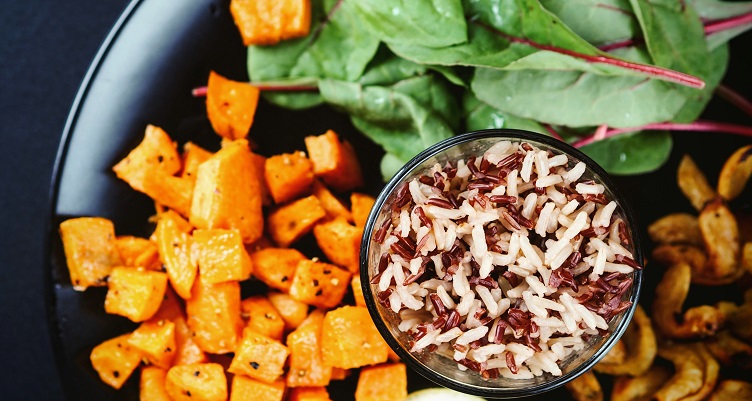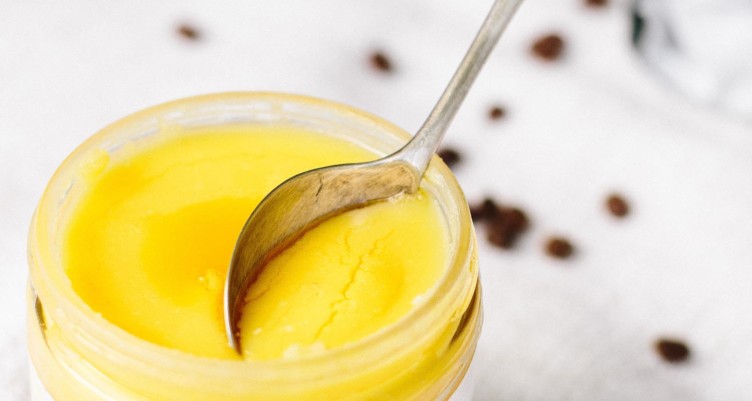Why Carb Cycling Can Be an Effective Strategy for Keto Dieters

- On keto, you get most of your calories from fat, moderate calories from protein and very few from carbohydrates. This combination puts you in a fat-burning state called ketosis.
- A carb cycling diet plan alternates between low- and high-carb days.
- Carb cycling has several potential benefits. It can support weight management, help with athletic performance and promote muscle growth.
Carbohydrates continue to be a hot topic in the world of nutrition. Both low-carb and ketogenic (keto) diets rely on specific macronutrient ratios to achieve a state of ketosis.[1]
But if heavily restricting carbs sounds too extreme, there is a happy medium: carb cycling. This style of eating gives you the best of both worlds by alternating between high-carb days and low-carb days. This way, you can have your cake and eat it, too (on a high-carb day, of course).
Keep reading to learn how carb cycling works. You’ll also discover its potential health benefits and how to incorporate it within the ketogenic lifestyle.
What Is Carb Cycling?
Carb cycling is a dietary plan in which you alternate your carb intake daily, weekly and monthly.[2] You may even have “no carb” days. The concept was developed by competitive bodybuilders who used it to burn fat, build muscle and train harder before an event.
For context, carbohydrates are the body’s most preferred source of energy.[3] There are two types of carbs: simple and complex carbs. Complex carbs are preferred because they digest more slowly, which helps prevent blood sugar spikes. Examples of simple carbs include white pasta, candy and soda. Examples of complex carbs include brown rice, quinoa and non-starchy vegetables.
Carb cycling is flexible and you can adjust it to fit your needs. A typical carb cycling plan may look like five or six “low-carb” days and one to two “high-carb” days. Many athletes and bodybuilders align high-carb days with high-intensity workouts. This comes down to science: Your body runs off glucose during your workouts. Consuming carbs after training will also help refuel your glycogen stores. This helps you get back into the gym sooner by preventing muscle soreness.[4]
What Are the Benefits of Carb Cycling?
Carb cycling can support weight management, break up the monotony of dieting and fuel your high-intensity workouts.
Since carb cycling has only recently gone mainstream, more research is needed to study its long-term effects.
Here are some of the proposed benefits of carb cycling:
Carb Cycling May Help With Weight Loss Plateaus
Plateau–it’s the dreaded word for anyone who’s trying to lose weight. One reason the scale stalls is due to metabolic adaptation. This is when your metabolism slows down in response to you consuming fewer calories.[5]
While you could cut more calories, a more pleasant option is carb cycling. It revs the metabolism up again and prevents metabolic adaptation. Additionally, switching between high-fat, low-carb days will help put your body in a fat-burning state.[6]

Carb Cycling May Increase Athletic Performance
Protein bars may be the standard pre-workout nutrition, but there are many benefits to carb loading. Eating carbs before high-intensity, short-duration exercise helps your body use glycogen as fuel.[7] Glycogen is another name for carbs stored in the liver and muscles.[8]
Exercise depletes glycogen stores. The rate at which this happens depends on the activity. Replenish your tank again by eating a variety of healthy carbohydrate sources, such as sweet potatoes, chocolate milk and rice.
On low-activity and low-carb days, increase your consumption of protein and healthy fats to aid in muscle recovery.
Related: How to Find Your Ideal Carb Intake
Carb Cycling May Help Regulate Hormones
Crash diets are a recipe for disaster. The risks include poor nutrition, disordered eating patterns and heart issues.[9]
They may also mess with your hormones, such as leptin, cortisol, estrogen and testosterone.
Leptin, for example, is an appetite suppressant and a weight-regulating hormone. When you reduce your calorie intake, leptin tells the brain to eat more to prevent starvation. Carb cycling may help improve leptin levels. For example, on high-carb days, eating more calories from carbohydrates improves leptin function. It also decreases hunger.[10]
Is Carb Cycling Safe?
As is the case with any diet, there may be an adjustment period. If restricting carbs is something your body isn’t used to, you may experience some of the side effects that are like the “keto flu.”
These symptoms include[11]:
- Fatigue
- Bloating
- Constipation
- Difficulty sleeping
- Feeling irritated
These symptoms typically last one to two weeks. Drinking lots of water and taking electrolytes can help. If symptoms persist, carb cycling might not be right for you. And that’s OK. Carb cycling isn’t for everyone.
Carb cycling isn’t recommended if you are pregnant or breastfeeding or have a past or current history of eating disorders.
How Does Carb Cycling Work?
A carb cycle plan alternates between low and high-carb days. This type of carbohydrate manipulation aims to match your body’s need for glucose.
For example, if you want to go hard in the gym, it’s a good day to increase your carbs. Carb-cycling meals may look like this:
- High-carb meal: Sprouted whole grain bread, lean turkey, avocado and mustard. As a side, have organic starchy veggies.
But if you’re resting that day, you can stick to a low-carb diet.
- Low-carb meal Grass-fed ground beef meatballs with homemade marinara sauce and zucchini noodles.
You can also increase your fat intake by adding Bulletproof Grass-Fed Ghee to your morning coffee. Or try whipping up some Keto White Chocolate Fat Bombs for an energy-boosting treat. For keto dieters, a low-carb day means following your typical macro ratios.

How to Carb Cycle
If carb cycling sounds right for you, you’re probably eager to get started and wondering where to begin. First, you need to figure out how many carbs per day you should be eating.
A carb cycling plan involves a ketogenic approach with lower-carb days. This means it’s important to understand how many carbs you should consume.
A good rule of thumb is 50 grams of total carbs per day. Your target might vary, though, depending on your diet and individual biology. If you’re still experiencing symptoms of the keto flu after the two-week mark, your body might be asking for more carbs.
For example, if you’re super active, you might need more than 50 grams of carbs per day. If you’re hitting 50 grams per day, but not factoring in net carbs, you might need to raise your daily carb intake. (To calculate net carbs, take your total carbs and subtract fiber and sugar alcohols.)
Sample Schedule
Here’s a typical week on a carb-cycling routine:
Can You Do Carb Cycling for Keto?
Carb cycling can support weight management, blood sugar control and insulin sensitivity. That said, it does not boast all the benefits of a keto diet. The lower-carb days on a carb cycling plan may still exceed the amount of carbs you need to consume to stay in nutritional ketosis. However, there is a way to carb cycle on a ketogenic diet through cyclical ketosis. In fact, it’s already built into the Bulletproof Diet.
This carb cycling approach allows you to pick one day per week to eat more high-quality carbs (approximately 150 grams of net carbs). On your carb refeed day, you can add things from this carb-cycling food list. This includes:
- Sweet potato
- Rice
- Butternut squash
- Carrots
- Plantains
- Low-sugar berries
Note that you may temporarily dip out of ketosis on your higher-carb day, but once your body burns through those extra carbs, you’ll return to ketosis. This is called metabolic flexibility. Carb cycling this way allows you to take advantage of all the keto and dirty keto benefits. These include appetite suppression, fat burning, improved energy and focus. Plus, you’ll still get the carbs your body needs to function.[12]

Other Types of Keto Diet
When it comes to the keto diet, you aren’t limited to one style of eating. There are variations of the ketogenic diet that can help you stay in a fat-burning state while increasing your carb intake.
These include:
- Targeted keto: This plan is great for athletes because you eat more carbs before you work out. That way, your muscles have glucose available to power through your session.
- Moderate keto: On this plan, you eat 100 to 150 grams of net carbs per day.
Related: The Keto Diet for Beginners: The Ultimate Guide
Experimenting with Exogenous Ketones
When you’re in ketosis, your body produces an alternative form of fuel called ketones. You can also supplement with exogenous ketones, which are ketones you ingest. Exogenous ketones can boost your ketone levels, which helps you stay in ketosis, even when you have some carbs in your system.[13]
Here are two types of exogenous ketones and important details about each to keep in mind:
- Ketone salts: Not all the ketones in ketone salts are bioidentical. This means the body may not be able to use them. Learn why you can skip most ketone salts.
- Ketone esters: This option is more effective than ketone salts, but keto esters have a chemical-like flavor. Plus, they’re expensive and not widely available.
Keep in mind that exogenous ketones are not necessary to maintain a state of ketosis. In fact, Bulletproof Brain Octane C8 MCT Oil is the happy medium between pure, nutritional ketosis and exogenous ketones. Since it’s pure C8 MCT oil, which is the most ketogenic MCT, it raises ketone levels four times more efficiently than coconut oil alone. That means more brain-powering, fat-burning keto benefits. You can add it to anything, from coffee to salad dressings.
Carb Cycling Tips
Use these tips to narrow down the best foods to eat while carb cycling:
- Choose high-quality carbs. On high-carb days, don’t use carb cycling as an excuse to binge on foods packed with artificial ingredients. Pass on simple sugars and refined carbs and choose unprocessed carbs instead. This includes sweet potatoes, whole grains and high-fiber fruits and vegetables.
- Prioritize fiber. On low-carb days, eat lots of fiber to reduce hunger.[14] Some of the best high-fiber, low-carb options include fruits like blackberries, raspberries and avocados. Other options include legumes like lentils and chickpeas. You can also eat eggs, walnuts and high-quality healthy fats like olive oil, grass-fed butter and fatty fish.
Carb cycling is a dieting approach that involves alternating low-carb days with high-carb days. The amount of carbs you consume per day often depends on your activity level. Carb cycling may help you break through weight management plateaus. It may also support building lean muscle mass and maximizing workout performance. As you try carb cycling, listen to your body. This will help you discover what works best for you and your health goals.
Sign up for early access to sales, product launches, the latest Bulletproof news and more!



